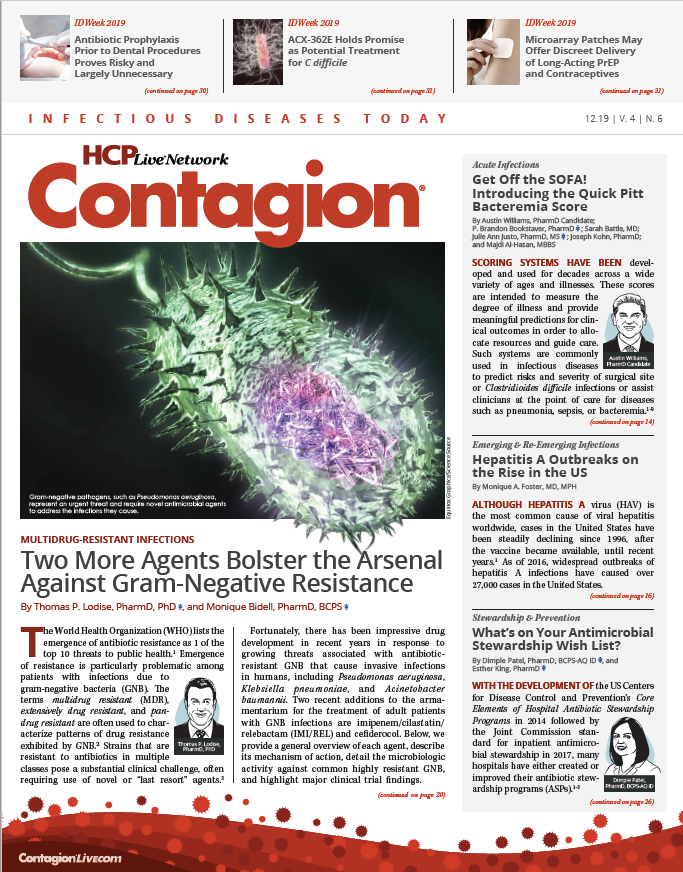All-Cause Mortality of Cefiderocol Versus Meropenem in Nosocomial Pneumonia
Investigators assessed rates of all-cause mortality at Day 14 for Cefiderocol and meropenem in patients with nosocomial gram-negative pneumonia.
Editors note: Updated October 4th at 1:00 PM
Cefiderocol is an experimental novel siderophore cephalosporin that has activity against a broad range of gram-negative bacteria. In a new study, investigators assessed rates of all-cause mortality at Day 14 for Cefiderocol and meropenem in patients with nosocomial gram-negative pneumonia.
The study team’s findings were presented in a late breaking oral abstract session at IDWeek 2019.
The trial was a phase 3, international, double-blind, non-inferiority study that enrolled patients with ventilator-associated, hospital-acquired, or health care-associated pneumonia caused by gram-negative bacteria.
Participants were randomized to receive either 2 grams of Cefiderocol every 8 hours, or 2 grams of meropenem every 8 hours, both of which were infused for 3 hours for 7-14 days. In both treatment arms adjunctive linezolid (600 mg, every 12h, ≥5 days) was given to cover gram-positive bacteria.
The primary end point was non-inferiority of Cefiderocol to meropenem for all-cause mortality at Day 14 in the modified intent-to-treat population. Secondary end points included clinical and microbiological outcomes at test of cure and Day 28 mortality. The study team also assessed safety up to 28 days following the termination of treatment.
In the intent-to-treat population, 148 patients were randomized to Cefiderocol and 150 participants were randomized to receive meropenem. In this population, 59.7% of participants were ventilated, 32.6% had documented failure of prior therapy, the median APACHE II score was 15, and 6.0% of participants had concomitant gram-negative bacteremia at baseline.
In the modified intent-to-treat population, non-inferiority of Cefiderocol to meropenem was demonstrated for Day 14 all-cause mortality (Cefiderocol: 12.4% [18 out of 145 participants] vs meropenem: 11.6% [17 out of 146 participants]; [treatment difference: 0.8; 95% confidence interval: —6.6; 8.2]).
“Comparable Day 28 all-cause mortality (Cefiderocol: 21.0% vs meropenem: 20.5%), clinical cure (Cefiderocol: 64.8% vs meropenem: 66.7%), and microbiological eradication (Cefiderocol: 47.6% vs meropenem: 48.0%) rates were demonstrated in the modified intent-to-treat population at test of cure,” the investigators wrote in their abstract.
The study team also reports that clinical cure rates for target pathogens at test-of-cure were similar between the Cefiderocol and meropenem arms. Additionally, the rates of adverse events, including treatment-emergent, drug related, and serious adverse events, as well as deaths, were similar between the 2 arms.
“This study demonstrated the non-inferiority of Cefiderocol to high-dose meropenem for the pre-specified endpoint of Day 14 all-cause mortality,” the investigators conclude. “No unexpected safety signals were observed in the study.”
The abstract, “Efficacy and Safety of Cefiderocol versus High-Dose Meropenem in Patients with Nosocomial Pneumonia — Results of a Phase 3 Randomized, Multicenter, Double-Blind, Non-Inferiority Study,” was presented in a late breaking oral abstract session on Thursday, October 3, 2019 in Washington, DC.

